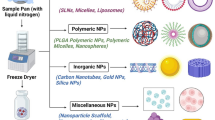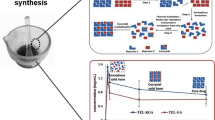Abstract
The purpose of this paper is to prepare a stable apigenin nanosuspension with a drug concentration of 1.11 mg/mL through green and efficient antisolvent method. Compared with the traditional preparation process that may use toxic reagents, in this study, a green and effective strategy was applied for the preparation of stable apigenin nanosuspension by using an antisolvent method with PEG 400 as antisolvent to improve the solubility and bioavailability. It was found that the particle size of apigenin nanosuspension was about 280 nm, and the solubility and dissolution of the nanosuspension were 33 and 3 times higher than that of the apigenin, respectively. Pharmacokinetic study showed that the Cmax and AUC 0–8 h values of the nanosuspension in fasting rats achieved about 6- and 2.5-fold enhancement than that of the apigenin, respectively. Stability test showed that the apigenin nanosuspension could be stored stably for 12 months at 25℃. Taken together, the antisolvent method with PEG 400 was proven to be a green and effective method to prepare the stable nanosuspension of poorly soluble drugs.







Similar content being viewed by others
References
Kim M, Jung J, Jeong NY, Chung HJ. The natural plant flavonoid apigenin is a strong antioxidant that effectively delays peripheral neurodegenerative processes. Anat Sci Int. 2019;94(4):285–94.
Venigalla M, Gyengesi E, Munch G. Curcumin and apigenin - novel and promising therapeutics against chronic neuroinflammation in Alzheimer’s disease. Neural Regen Res. 2015;10(8):1181–5.
Sanadgol N, Zahedani SS, Sharifzadeh M, Khalseh R, Barbari GR, Abdollahi M. Recent updates in imperative natural compounds for healthy brain and nerve function: a systematic review of implications for multiple sclerosis. Curr Drug Targets. 2017;18(13):1499–517.
Shakeel F, Alshehri S, Ibrahim MA, Elzayat EM, Altamimi MA, Mohsin K, et al. Solubility and thermodynamic parameters of apigenin in different neat solvents at different temperatures. J Mol Liq. 2017;234:73–80.
Huang S, Xue Q, Xu J, Ruan S, Cai T. Simultaneously improving the physicochemical properties, dissolution performance, and bioavailability of apigenin and daidzein by co-crystallization with theophylline. J Pharm Sci. 2019;108(9):2982–93.
Chen YC, Liu Y, Xu JN, Xie J, Ma YQ, Yue PF, et al. Design and evaluation of nanocomposite microparticles to enhance dissolution and oral bioavailability of andrographolide. Powder Technol. 2018;323:219–29.
Zawar LR, Bari SB. Preparation, characterization and in vivo assessment of repaglinide nanosuspension for oral bioavailability improvement. Recent Pat Drug Deliv Formul. 2018;12(3):162–9.
Sattar A, Chen D, Jiang L, Pan Y, Tao Y, Huang L, et al. Preparation, characterization and pharmacokinetics of cyadox nanosuspension. Sci Rep. 2017;7(1):2289.
Farokhzad OC, Langer R. Impact of nanotechnology on drug delivery. ACS Nano. 2009;3(1):16–20.
Singh SK, Vaidya Y, Gulati M, Bhattacharya S, Garg V, Pandey NK. Nanosuspension: principles, perspectives and practices. Curr Drug Deliv. 2016;13(8):1222–46.
Qian YS, Ramamurthy S, Candasamy M, Shadab M, Kumar RH, Meka VS. Production, characterization and evaluation of kaempferol nanosuspension for improving oral bioavailability. Curr Pharm Biotechnol. 2016;17(6):549–55.
Fujimura H, Komasaka T, Tomari T, Kitano Y, Takekawa K. Nanosuspension formulations of poorly water-soluble compounds for intravenous administration in exploratory toxicity studies: in vitro and in vivo evaluation. J Appl Toxicol. 2016;36(10):1259–67.
Khanuja HK, Awasthi R, Mehta M, Satija S, Aljabali AA, Tambuwala MM, et al. Nanosuspensions - an update on recent patents, methods of preparation, and evaluation parameters. Recent Pat Nanotechnol. 2020. https://doi.org/10.2174/1872210514666201224103010.
Al Shaal L, Shegokar R, Muller RH. Production and characterization of antioxidant apigenin nanocrystals as a novel UV skin protective formulation. Int J Pharm. 2011;420(1):133–40.
Gora S, Mustafa G, Sahni JK, Ali J, Baboota S. Nanosizing of valsartan by high pressure homogenization to produce dissolution enhanced nanosuspension: pharmacokinetics and pharmacodyanamic study. Drug Deliv. 2016;23(3):940–50.
Wu W, Zu Y, Zhao X, Zhang X, Wang L, Li Y, et al. Solubility and dissolution rate improvement of the inclusion complex of apigenin with 2-hydroxypropyl-beta-cyclodextrin prepared using the liquid antisolvent precipitation and solvent removal combination methods. Drug Dev Ind Pharm. 2017;43(8):1366–77.
Zhang J, Huang Y, Liu D, Gao Y, Qian S. Preparation of apigenin nanocrystals using supercritical antisolvent process for dissolution and bioavailability enhancement. Eur J Pharm Sci. 2013;48(4–5):740–7.
Ahmadi Tehrani A, Omranpoor MM, Vatanara A, Seyedabadi M, Ramezani V. Formation of nanosuspensions in bottom-up approach: theories and optimization. Daru. 2019;27(1):451–73.
Murnane D, Marriott C, Martin GP. Developing an environmentally benign process for the production of microparticles: amphiphilic crystallization. Eur J Pharm Biopharm. 2008;69(1):72–82.
Kardooni R, Kiasat AR. A green, catalyst-free synthesis of pyrazolopyranopyrimidines in polyethylene glycol as a biodegradable medium at ambient temperature. Mol Divers. 2019;23(3):639–49.
Chen J, Spear SK, Huddleston JG, Rogers RD. Polyethylene glycol and solutions of polyethylene glycol as green reaction media. Green Chem. 2005;7:64–82.
Singh P, Pandey S. Solute-solvent interactions within aqueous poly(ethylene glycol): solvatochromic probes for empirical determination and preferential solvation. Green Chem. 2007;9:254–61.
Aghajanzadeh M, Zamani M, Rashidzadeh H, Rostamizadeh K, Sharafi A, Danafar H. Amphiphilic Y shaped miktoarm star copolymer for anticancer hydrophobic and hydrophilic drugs codelivery: synthesis, characterization, in vitro, and in vivo biocompatibility study. J Biomed Mater Res A. 2018;106(11):2817–26.
Kumar R, Chaudhary P, Nimesh S, Chandra R. Polyethylene glycol as a non-ionic liquid solvent for Michael addition reaction of amines to conjugated alkenes. Green Chem. 2006;8:356–8.
Liu Q, Guan J, Sun Z, Shen X, Li L, Jin L, et al. Influence of stabilizer type and concentration on the lung deposition and retention of resveratrol nanosuspension-in-microparticles. Int J Pharm. 2019;569:118562.
Kassem MAA, ElMeshad AN, Fares AR. Enhanced solubility and dissolution rate of lacidipine nanosuspension: formulation via antisolvent sonoprecipitation technique and optimization using Box-Behnken design. AAPS PharmSciTech. 2017;18(4):983–96.
Wang Y, Zheng Y, Zhang L, Wang Q, Zhang D. Stability of nanosuspensions in drug delivery. J Control Release. 2013;172(3):1126–41.
Hwang SH, Paek JH, Lim SS. Simultaneous ultra performance liquid chromatography determination and antioxidant activity of linarin, luteolin, chlorogenic acid and apigenin in different parts of Compositae species. Molecules. 2016;21(11):1609.
Zhu S, Zhang J, Lv Z, Yu M. LC-MS/MS determination of apigenin in rat plasma and application to pharmacokinetic study. Curr Pharm Biotechnol. 2021;22(2):274–80.
Castillo B, Mendez J, Al-Azzam W, Barletta G, Griebenow K. On the relationship between the activity and structure of PEG-alpha-chymotrypsin conjugates in organic solvents. Biotechnol Bioeng. 2006;94(3):565–74.
Veronese FM, Mero A. The impact of PEGylation on biological therapies. BioDrugs. 2008;22(5):315–29.
D’Souza AA, Shegokar R. Polyethylene glycol (PEG): a versatile polymer for pharmaceutical applications. Expert Opin Drug Deliv. 2016;13(9):1257–75.
Mahesh KV, Singh SK, Gulati M. A comparative study of top-down and bottom-up approaches for the preparation of nanosuspensions of glipizide. Powder Technol. 2014;256:436–49.
Guo CY, Chen YN, Zhu JZ, Wang JX, Xu Y, Luan HS, et al. Optimization of extended-release ZL-004 nanosuspensions for in vivo pharmacokinetic study to enhance low solubility and compliance. Molecules. 2018;24(1):7.
Mostafa N; Ranjita S; Jean-René A; Tharwat T. Nano-crystalline suspensions by top down processes: review of manufacturing considerations. Drug Deliv Letters. 2018;8(3):184–99.
Bharate SS, Vishwakarma RA. Impact of preformulation on drug development. Expert Opin Drug Deliv. 2013;10(9):1239–57.
Ammann C. Stability studies needed to define the handling and transport conditions of sensitive pharmaceutical or biotechnological products. AAPS PharmSciTech. 2011;12(4):1264–75.
Funding
This work was supported by grants from Qing Miao Plan of Hubei University of Chinese Medicine (1008010511).
Author information
Authors and Affiliations
Contributions
Conceptualization: Shan Lu and Xuechen Xiao. Methodology: Lijing Zhou and Renjie Xu. Formal analysis and investigation: Yi Hu and Bin Li. Writing-original draft preparation: Renjie Xu. Writing-review and editing: Cuiping Jiang and Yujie Guo. Funding acquisition: Yujie Guo and Shan Lu. Resources: Yujie Guo and Shan Lu. Supervision: Shan Lu and Xuechen Xiao. All authors read and approved the final manuscript.
Corresponding authors
Ethics declarations
Conflict of Interest
The authors declare no competing interests.
Additional information
Publisher's Note
Springer Nature remains neutral with regard to jurisdictional claims in published maps and institutional affiliations.
Rights and permissions
About this article
Cite this article
Xu, R., Jiang, C., Zhou, L. et al. Fabrication of Stable Apigenin Nanosuspension with PEG 400 as Antisolvent for Enhancing the Solubility and Bioavailability. AAPS PharmSciTech 23, 12 (2022). https://doi.org/10.1208/s12249-021-02164-x
Received:
Accepted:
Published:
DOI: https://doi.org/10.1208/s12249-021-02164-x




